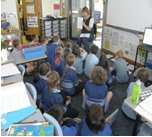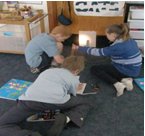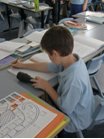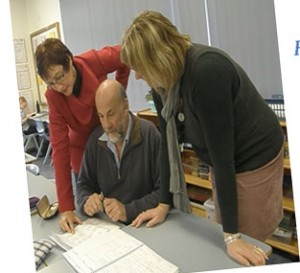Inquiry into Science Inquiry
By John R. Stiles, Ph.D.
Science Education consultant
Bangkok
jsscience@yahoo.com
For at least the past three decades, what is now known as “Science Inquiry” has been the prevailing paradigm among science educators. However, acceptance from classroom science teachers, administrators, and university science instructors has been slow.
The U. S. National Science Education Standards first drafted in 1996 included science inquiry as one of its standards, underscoring the idea that inquiry is not only important in school science, but also fundamental:
“The Standards call for more than “science as process,” in which students learn such skills as observing, inferring, and experimenting. Inquiry is central to science learning. When engaging in inquiry, students describe objects and events, ask questions, construct explanations, test those explanations against current scientific knowledge, and communicate their ideas to others. They identify their assumptions, use critical and logical thinking, and consider alternative explanations. In this way, students actively develop their understanding of science by combining scientific knowledge with reasoning and thinking skills.
“The importance of inquiry does not imply that all teachers should pursue a single approach to teaching science. Just as inquiry has many different facets, so teachers need to use many different strategies to develop the understandings and abilities described in the Standards” (National Academies Press).
While traditional science textbooks have devoted but a single chapter to science inquiry, generally the introductory chapter (“What do scientists do?”), it was not necessarily encouraged as an integrated part of classroom science beyond the first week. As the research base on science teaching and learning has evolved, even that introduction was revised, as such widely accepted, but mythological notions such as “The” Scientific Method needed to be re-thought (McComas, 1996). As early as the 1980’s, scientists also recognized that school science did not accurately reflect what science is, and joined science educators’ call for a redefining of teaching and learning. F. James Rutherford, science education pioneer, noted that teachers, particularly those in elementary levels, needed to be “re-educated” about the nature of science, and that science textbooks should be removed from the elementary schools because they “get in the way of good science instruction” (Rutherford, 1987). Rutherford echoed the position of other prominent science educators, such as Robert Yager, who in 1988 scolded school science instruction for rarely permitting students to investigate authentic scientific problems (Clough, 2000).
As science education research dramatically increased throughout the end of the 20th century, more and more, educators realized that school science was not reflecting the nature of science, which informs science education about what science is and how it works (Clough, 2000). Textbooks attempted to change their format to assimilate the shifting paradigm but with varying degrees of success. In short, the nature of science is not something easily read about, but rather something that needs to be experienced. As Colburn and Clough (1997) noted that in textbook science, “students are rarely mentally engaged in a meaningful manner.” Indeed, as Nobel prize-winning physicist Richard Feynman (1985) concluded after being asked to review a physics text, there was “no science” in it, “only memorization.”
Because of this shift in thinking about how and why school science needed to be more thoughtful regarding science teaching and learning, an evolution began of what classroom instruction should look like. Along with the development of the “Learning Cycle” strategy by Robert Karplus (1972), science educators gradually came to a consensus regarding what the research says about “science inquiry,” galvanized in five identified and widely recognized “Essential Features” (National Academy of Sciences, 2000). These five features and a short summary of each are as follows:
- The learner engages in scientifically oriented questions. The questions may come from one posed by the teacher, from students themselves, or from outside resources, such as a textbook, video or internet site.
- The learner gives priority to evidence in responding to questions. Students are given opportunity to explore ways to find credible evidence and gather data.
- The learner formulates explanations from evidence. Students discuss the evidence and give their own explanations regarding the findings.
- The learner connects explanations to scientific knowledge. Unlike traditional science instruction, students do not research information from experts until after formulating their own explanations. The “experts’ may be the classroom teacher, scientists, other science professionals, literary or electronic sources. The students then reconcile any differences between their findings and scientific explanations. This can be done in a variety of ways.
- The learner communicates and justifies explanations. Students report their findings, preferably in a public setting, either in class presentations or for a wider audience, such as to other classes, teachers, school-wide forums or conferences, or through self-publishing available to the school community or a wider audience via social platforms or other educational web sites.
The Essential Features are not necessarily required for all science instruction, nor are all five required in each investigation. However, science educators encourage teachers to use all five features at some point in their school year. Depending on how comfortable teachers and their students are with science inquiry, and the experience that both have had using science inquiry, there will be a wide range of science inquiry actually used in each classroom, and at different levels. The goal is to engage in scientific inquiry as often as possible at all levels of instruction when practical.
As in any endeavor, it is not enough to simply read about science inquiry and be able to implement it any more than it is possible to compose a song by reading a passage in a music book. Science inquiry, to be done correctly and effectively, takes time and requires practice, taking small steps. Some commercial science kits are available, such as FOSS (Full Option Science Systems), which are made to be used with an inquiry approach, and comes with teacher guides and videos that instruct how to set-up for investigations.
Also important is to understand what misconceptions teachers have about science inqiry. Here are just a few:
- Myth #1: Inquiry Science is the teacher asking “recall” questions.
Answering rhetorical or simple yes-no types of questions does not require critical thinking skills.
- Myth #2: Inquiry science involves students learning only facts of already acquired knowledge.
Although important, facts support the development of conceptual knowledge, but cannot, in isolation, possibly lead to understanding.
- Myth #3: Inquiry science is learning science process skills.
While these skills are necessary, they alone do not result in student understanding of scientific concepts.
- Myth #4: Inquiry science follows the “Scientific Method.”
Surprising to many science teachers, there is no such thing as the scientific method.
While scientists use many of these steps, they are not essential in science discovery.
Scientific discoveries occur using a variety of approaches, including accidental
discoveries.
- Myth #5: Inquiry science is “hands-on” or “discovery” science.
While using manipulatives or allowing students to independently explore are important
aspects of science investigation, they alone are insufficient for deep conceptual
understanding.
These and other myths of science inquiry teaching and learning often inhibit deep student
understanding of science concepts and content, as well as give a misrepresentation as to
what science is and what scientists do.
Thailand’s Science Standards English Version drafted in 2008 (B.E. 2551) include references to scientific inquiry in school science. Specifically, Standard Sc 8.1 states: “The student should be able to use the scientific process and scientific mind in investigation, solve problems, know that most natural phenomena have definite patterns explainable and verifiable within the limitations of data and instrumentation during the period of investigation, understand that science, technology and environment are interrelated” (Institute for the Promotion of teaching Science and Technology [IPST], 2008).
Although inquiry is not explicitly described, it is implied in the standard. When reviewing the indicators for Nature of Science in the Thai science standards (all grade levels), many of the Essential Features of Inquiry are present, such as:
- Pose questions, based on scientific knowledge and understanding, own interests, or current issues, that can be investigated comprehensively and reliably.
- Search and collect data
- Analyse and interpret data
- Record and explain results of an observation, investigation and additional research from various sources, in order to obtain reliable information
- (O)ffering explanations, viewpoints, and results of scientific learning to the public
This year and next, Thailand is undergoing further review of its standards and benchmarks, as are many other countries. An outside team of science, math and technology experts from The U.S., U.K. and Australia will review and make recommendations to a team of educators from IPST. After gathering feedback from Thai teachers and administrators, a final revision will be made and recommendations sent to the Ministry of Education for approval sometime in mid-2012 (B.E. 2555).
References
Clough, M.P. (2000). The nature of science: Understanding how the game is played. EBSCO Clearinghouse; Sep/Oct, Vol 74 (1): 13-17. ISSN: 0009-8655. Accession number: 3537010, Professional Development Collection.
Colburn, A. & Clough, M.P. (1997). Implementing the Learning Cycle. The Science Teacher, 64 (5): 30-33.
Feynman, Richard P. (1985). Surely you’re joking Mr. Feynman! (Adventures of a curious character). New York: W.W. Norton & Company, Inc.
Institute for the Promotion of teaching Science and Technology (2008). The Basic Education Core Curriculum B.E. 2551; Science.
Karplus, R. (1972). SCIS: Three guidelines for elementary school science. Science Activities, 8 (1): 47-49.
McComas, W. (1996). Ten myths of science: Reexamining what we think we know…School Science & Mathematics, 96 (January) 10pp.
National Academy of Sciences (2000). Inquiry and the National Science Education Standards: A guide for teaching and learning. Washington, D.C.: National Academies Press.
National Academy of Sciences (1996). National Science Education Standards. Washington, D.C.: National Academies Press.












